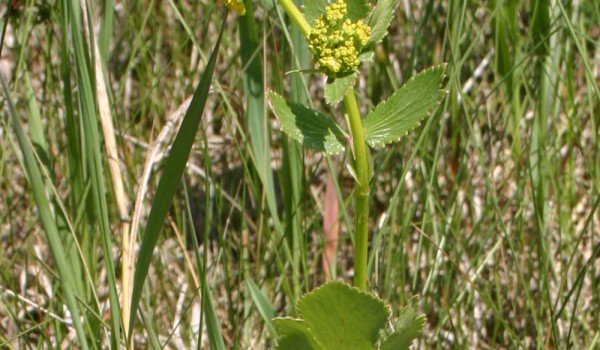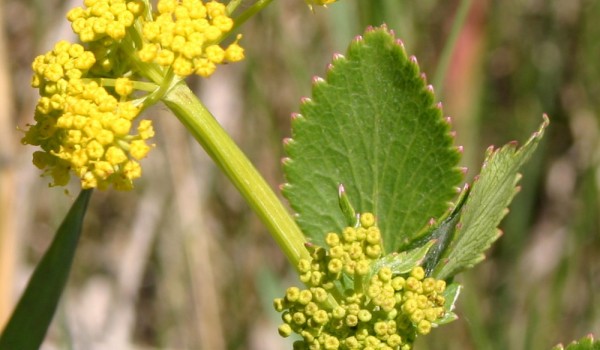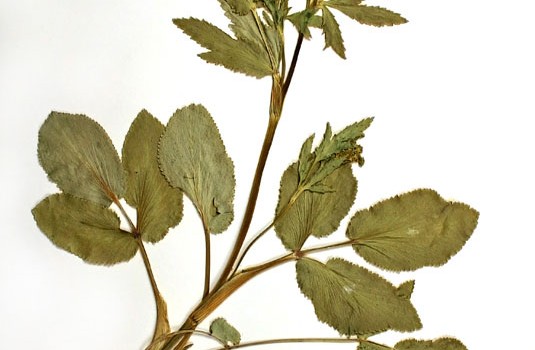Parsely (Apiaceae)
Heart-leaved Alexander
Zizia aptera (Gray) Fern.The common name of this Alexander comes from the heart-shaped leaves at the base of its stem. Although it is also known as meadow-parsnip, these plants are not used for food. Some related species are toxic, and should not be eaten. These plants provide nectar and pollen as food for many insects active in the spring such as bees, flies, and beetles, and are visited frequently. Fruits are wingless and split into two seeds.
Flower Colour:
- Yellow
Flowering Season:
- Spring
Flowering Months:
- June
- May
Canadian Rarity Status:
Not rare. Listed as “may be at risk” in Ontario, and “exotic” in Quebec.
Physical Appearance:
The clustered, branching stems of this perennial plant are reddish and grow 20-60 cm tall. Basal leaves have long-stalks and are heart-shaped with toothed margins. Stem leaves are also toothed, but divided into 3-5 leaflets. The numerous flowers are small and have five yellow petals. They occur in small clusters arranged into larger, dense, umbrella-shaped clusters. The oval-shaped dry fruits are hairless, wingless, and split into two seeds.
Similar Species:
Golden Alexander, Hairy Parsley (Lomatium foeniculaceum (Nutt.) C. & R.), Large-fruited Parsley (Lomatium macrocarpum (Nutt. ex T. & G.) C. & R.), Leafy Musineon (Musineon divaricatum (Pursh) Nutt. ex T. & G.)
Gardening Notes:
Seeds and/or plants are typically available from greenhouses and seed supply companies specializing in native plants.
Canadian Distribution:
- Alberta
- British Columbia
- Manitoba
- Ontario
- Saskatchewan
Prairie Types:
- Fescue Prairie
- Mixed Grass Prairie
- Tall Grass Prairie
Habitats:
- Open Woodlands
- Prairies
- Roadsides
Moisture Conditions:
- Moderate
- Moist
Light Preference:
- Full Sun
- Part Shade
Soil Preference:
- Loam
- Sand
Associated Pollinators:
-
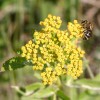 Andrenid Bees, Miner/Digger Bees (Andrenidae)
Andrenid Bees, Miner/Digger Bees (Andrenidae)
-
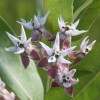 Ants (Formicidae)
Ants (Formicidae)
-
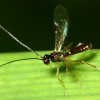 Braconid Wasps (Braconidae)
Braconid Wasps (Braconidae)
-
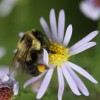 Bumble, Honey, and other Bees (Apidae (Subfamily Apinae))
Bumble, Honey, and other Bees (Apidae (Subfamily Apinae))
-
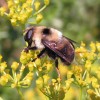 Flower Flies (Syrphidae)
Flower Flies (Syrphidae)
-
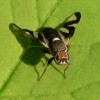 Fruit Flies (Tephritidae)
Fruit Flies (Tephritidae)
-
 Grass Flies (Chloropidae)
Grass Flies (Chloropidae)
-
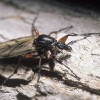 March Flies (Bibionidae)
March Flies (Bibionidae)
-
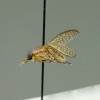 Marsh Flies (Sciomyzidae)
Marsh Flies (Sciomyzidae)
-
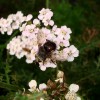 Parasitic Flies (Tachinidae)
Parasitic Flies (Tachinidae)
-
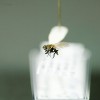 Root Maggot Flies (Anthomyiidae)
Root Maggot Flies (Anthomyiidae)
-
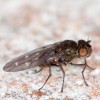 Shore Flies (Ephydridae)
Shore Flies (Ephydridae)
-
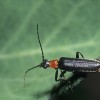 Soldier Beetles (Cantharidae)
Soldier Beetles (Cantharidae)
-
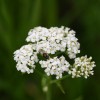 Soldier Flies (Stratiomyidae)
Soldier Flies (Stratiomyidae)
-
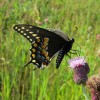 Swallowtail Butterflies (Papilionidae)
Swallowtail Butterflies (Papilionidae)
-
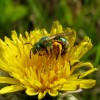 Sweat Bees, Halictid Bees and other Bees (Halictidae)
Sweat Bees, Halictid Bees and other Bees (Halictidae)
-
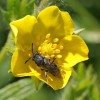 Yellow-faced Bees (Colletidae)
Yellow-faced Bees (Colletidae)
-
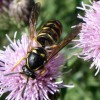 Yellowjacket, Potter, and other Wasps (Vespidae)
Yellowjacket, Potter, and other Wasps (Vespidae)






